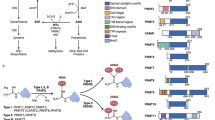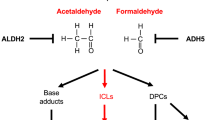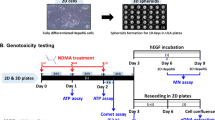Abstract
Arsenic, an established carcinogen and toxicant, occurs in drinking water and food and affects millions of people worldwide. Arsenic appears to interfere with gene expression through epigenetic processes, such as DNA methylation and post-translational histone modifications. We investigated the effects of arsenic on histone residues in vivo as well as in vitro. Analysis of H3K9Ac and H3K9me3 in CD4+ and CD8+ sorted blood cells from individuals exposed to arsenic through drinking water in the Argentinean Andes showed a significant decrease in global H3K9me3 in CD4+ cells, but not CD8+ cells, with increasing arsenic exposure. In vitro studies of inorganic arsenic-treated T lymphocytes (Jurkat and CCRF-CEM, 0.1, 1, and 100 μg/L) showed arsenic-related modifications of H3K9Ac and changes in the levels of the histone deacetylating enzyme HDAC2 at very low arsenic concentrations. Further, in vitro exposure of kidney HEK293 cells to arsenic (1 and 5 μM) altered the protein levels of PCNA and DNMT1, parts of a gene expression repressor complex, as well as MAML1. MAML1 co-localized and interacted with components of this complex in HEK293 cells, and in silico studies indicated that MAML1 expression correlate with HDAC2 and DNMT1 expression in kidney cells. In conclusion, our data suggest that arsenic exposure may lead to changes in the global levels of H3K9me3 and H3K9Ac in lymphocytes. Also, we show that arsenic exposure affects the expression of PCNA and DNMT1—proteins that are part of a gene expression silencing complex.





Similar content being viewed by others
Abbreviations
- DMA:
-
Dimethylarsinic acid
- DNMT1:
-
DNA (cytosine-5)-methyltransferase 1
- HDCA2:
-
Histone deacetylase 2
- ICP-MS:
-
Inductively coupled plasma mass spectrometry
- MAML1:
-
Mastermind-like 1
- MMA:
-
Methylarsonic acid
- PCNA:
-
Proliferating cell nuclear antigen
References
Ahmed S et al. Arsenic-associated oxidative stress, inflammation, and immune disruption in human placenta and cord blood. Environ Health Perspect. 2011;119(2):258–64.
Ahmed S et al. Arsenic exposure and cell-mediated immunity in pre-school children in rural Bangladesh. Toxicol Sci: Off J Soc Toxicol. 2014;141(1):166–75.
Allan RS et al. An epigenetic silencing pathway controlling T helper 2 cell lineage commitment. Nature. 2012;487(7406):249–53.
Bannister AJ, Kouzarides T. Regulation of chromatin by histone modifications. Cell Res. 2011;21(3):381–95.
Broberg K et al. Arsenic exposure in early pregnancy alters genome-wide DNA methylation in cord blood, particularly in boys. J Dev Origins Health Dis. 2014;5(4):288–98.
Chervona Y et al. Associations between arsenic exposure and global posttranslational histone modifications among adults in Bangladesh. Cancer Epidemiology, Biomarkers Prevention: Publ Am Assoc Cancer Res, Cosponsored Am Soc Preventive Oncol. 2012;21(12):2252–60.
Christine Kim Dan T, J.O.G.-M.L.L.G. Arsenic inhibits DNA mismatch repair by altering PCNA function. FASEB J. 2014;28(1), 735.9.
Concha G, Nermell B, Vahter MV. Metabolism of inorganic arsenic in children with chronic high arsenic exposure in northern Argentina. Environ Health Perspect. 1998;106(6):355–9.
Cronican AA et al. Genome-wide alteration of histone H3K9 acetylation pattern in mouse offspring prenatally exposed to arsenic. PLoS One. 2013;8(2), e53478.
Das M et al. Promoter methylation of MGMT gene in serum of patients with esophageal squamous cell carcinoma in North East India. Asian Pac J Cancer Prev. 2014;15(22):9955–60.
Du J et al. Arsenic induces functional re-expression of estrogen receptor α by demethylation of DNA in estrogen receptor-negative human breast cancer. PLoS One. 2012;7(4), e35957.
Engström K et al. EHP—polymorphisms in arsenic(+III oxidation state) methyltransferase (AS3MT) predict gene expression of AS3MT as well as arsenic metabolism. Environ Health Perspectives, 2011; 119.
Gautier L et al. Affy—analysis of Affymetrix GeneChip data at the probe level. Bioinformatics. 2004;20(3):307–15.
Ge R et al. DNA methyl transferase 1 reduces expression of SRD5A2 in the aging adult prostate. Am J Pathol. 2015;185(3):870–82.
Ha M et al. Coordinated histone modifications are associated with gene expression variation within and between species. Genome Res. 2011;21(4):590–8.
Hall MN, Gamble MV. Nutritional manipulation of one-carbon metabolism: effects on arsenic methylation and toxicity. J Toxicol, 2012; p.595307.
Hansson ML et al. The transcriptional coactivator MAML1 regulates p300 autoacetylation and HAT activity. Nucleic Acids Res. 2009a;37(9):2996–3006.
Hansson ML et al. The transcriptional coactivator MAML1 regulates p300 autoacetylation and HAT activity. Nucleic Acids Res. 2009b;37(9):2996–3006.
Harari F, et al. EHP—N-6-adenine-specific DNA methyltransferase 1 (N6AMT1) polymorphisms and arsenic methylation in Andean women. Environ Health Perspectives, 2013; 121(7).
Hong G-M, Bain LJ. Sodium arsenite represses the expression of myogenin in C2C12 mouse myoblast cells through histone modifications and altered expression of Ezh2, Glp, and Igf-1. Toxicol Appl Pharmacol. 2012;260(3):250–9.
Hong C-S et al. HOXB5 induces invasion and migration through direct transcriptional up-regulation of β-catenin in human gastric carcinoma. Biochem J. 2015;472(3):393–403.
Jiang N et al. Dietary and genetic effects on age-related loss of gene silencing reveal epigenetic plasticity of chromatin repression during aging. Aging (Albany NY). 2013;5(11):813–24.
Kallestad L et al. Transcriptional repression is epigenetically marked by H3K9 methylation during SV40 replication. Clin Epigenetics. 2014;6(1):21.
Karmodiya K et al. H3K9 and H3K14 acetylation co-occur at many gene regulatory elements, while H3K14ac marks a subset of inactive inducible promoters in mouse embryonic stem cells. BMC Genomics. 2012;13(1):424.
Kilpinen S et al. Systematic bioinformatic analysis of expression levels of 17,330 human genes across 9,783 samples from 175 types of healthy and pathological tissues. Genome Biol. 2008;9(9):R139.
Kim J, Kim H. Recruitment and biological consequences of histone modification of H3K27me3 and H3K9me3. ILAR J/National Res Council, Institute Laboratory Animal Resources. 2012;53(3–4):232–9.
Kort EJ et al. The E2F3-Oncomir-1 axis is activated in Wilms’ tumor. Cancer Res. 2008;68(11):4034–8.
Li Z et al. Methylation-associated silencing of microRNA-335 contributes tumor cell invasion and migration by interacting with RASA1 in gastric cancer. Am J Cancer Res. 2014;4(6):648–62.
Li H et al. Arsenic trioxide inhibits DNA methyltransferase and restores TMS1 gene expression in K562 cells. Acta Haematol. 2015;133(1):18–25.
Litvinov IV et al. Ectopic expression of embryonic stem cell and other developmental genes in cutaneous T-cell lymphoma. Oncoimmunology. 2014;3(11), e970025.
Lopez-Carrillo L et al. Arsenic methylation capacity is associated with breast cancer in northern Mexico. Toxicol Appl Pharmacol. 2014;280(1):53–9.
Nermell B et al. Urinary arsenic concentration adjustment factors and malnutrition. Environ Res. 2008;106(2):212–8.
Noh K-M, Allis CD, Li H. Reading between the lines: “ADD”-ing histone and DNA methylation marks toward a new epigenetic “sum”. ACS Chem Biol. 2016;11(3):554–63.
Pauler FM et al. H3K27me3 forms BLOCs over silent genes and intergenic regions and specifies a histone banding pattern on a mouse autosomal chromosome. Genome Res. 2009;19(2):221–33.
Peng S et al. HDAC2 selectively regulates FOXO3a-mediated gene transcription during oxidative stress-induced neuronal cell death. J Neurosci. 2015;35(3):1250–9.
Pournara A, et al. Arsenic-induced suppression of kidney cell proliferation and the transcriptional coregulator MAML1. Metallomics : Integrated Biometal Sci. 2014
Rager JE, Yosim A, Fry RC. Prenatal exposure to arsenic and cadmium impacts infectious disease-related genes within the glucocorticoid receptor signal transduction pathway. Int J Mol Sci. 2014;15(12):22374–91.
Ramirez T et al. Sodium arsenite modulates histone acetylation, histone deacetylase activity and HMGN protein dynamics in human cells. Chromosoma. 2008;117(2):147–57.
Raqib R et al. Effects of in utero arsenic exposure on child immunity and morbidity in rural Bangladesh. Toxicol Lett. 2009;185(3):197–202.
Rawat M, Bhosale MA, Karmodiya K. Plasmodium falciparum epigenome: a distinct dynamic epigenetic regulation of gene expression. Genomics Data. 2016;7:79–81.
Rose NR, Klose RJ. Understanding the relationship between DNA methylation and histone lysine methylation. Biochim Biophys Acta. 2014;1839(12):1362–72.
Rountree MR, Bachman KE, Baylin SB. DNMT1 binds HDAC2 and a new co-repressor, DMAP1, to form a complex at replication foci. Nat Genet. 2000;25(3):269–77.
Sumi D, Himeno S. Role of arsenic (+3 oxidation state) methyltransferase in arsenic metabolism and toxicity. Biol Pharm Bull. 2012;35(11):1870–5.
Tellez-Plaza M et al. Association of global DNA methylation and global DNA hydroxymethylation with metals and other exposures in human blood DNA samples. Environ Health Perspect. 2014;122(9):946–54.
Tseng CH. A review on environmental factors regulating arsenic methylation in humans. Toxicol Appl Pharmacol. 2009;235(3):338–50.
Tyler CR et al. ChIP-Seq analysis of the adult male mouse brain after developmental exposure to arsenic. Data Brief. 2015;5:248–54.
Vahter M. Mechanisms of arsenic biotransformation. Toxicology. 2002;181–182:211–7.
Vahter M et al. A unique metabolism of inorganic arsenic in native Andean women. Eur J Pharmacol. 1995;293(4):455–62.
Xu G et al. The histone methyltransferase Smyd2 is a negative regulator of macrophage activation by suppressing interleukin 6 (IL-6) and tumor necrosis factor alpha (TNF-alpha) production. J Biol Chem. 2015;290(9):5414–23.
Zhao L et al. Transcriptional regulation of cell cycle genes in response to abiotic stresses correlates with dynamic changes in histone modifications in maize. PLoS One. 2014;9(8), e106070.
Acknowledgments
We would like to thank Dr. Florencia Harari, Dr. Gabriela Concha, Brita Palm, and Margaretha Grandér for their valuable help with the collection of the blood and urine samples from the Argentinean women as well as the arsenic speciation.
This work was supported by grants from the Swedish Cancer and Allergy Fund to A.E.W. and the Karolinska Institutet to M.V., K.B., and A.E.W. The funders had no role in study design, data collection and analysis, decision to publish, or preparation of the manuscript.
Author information
Authors and Affiliations
Corresponding author
Ethics declarations
Ethical permit was obtained from the Stockholm Regional Ethical Review Board and the Ministry of Health in Salta, Argentina (2008/1430-31).
Competing interests
The authors declare that they have no competing interests.
Electronic supplementary material
Below is the link to the electronic supplementary material.
Supplemental Figure S1
(PPTX 562 kb)
Supplemental Figure S2
(PPTX 89 kb)
Rights and permissions
About this article
Cite this article
Pournara, A., Kippler, M., Holmlund, T. et al. Arsenic alters global histone modifications in lymphocytes in vitro and in vivo. Cell Biol Toxicol 32, 275–284 (2016). https://doi.org/10.1007/s10565-016-9334-0
Received:
Accepted:
Published:
Issue Date:
DOI: https://doi.org/10.1007/s10565-016-9334-0




